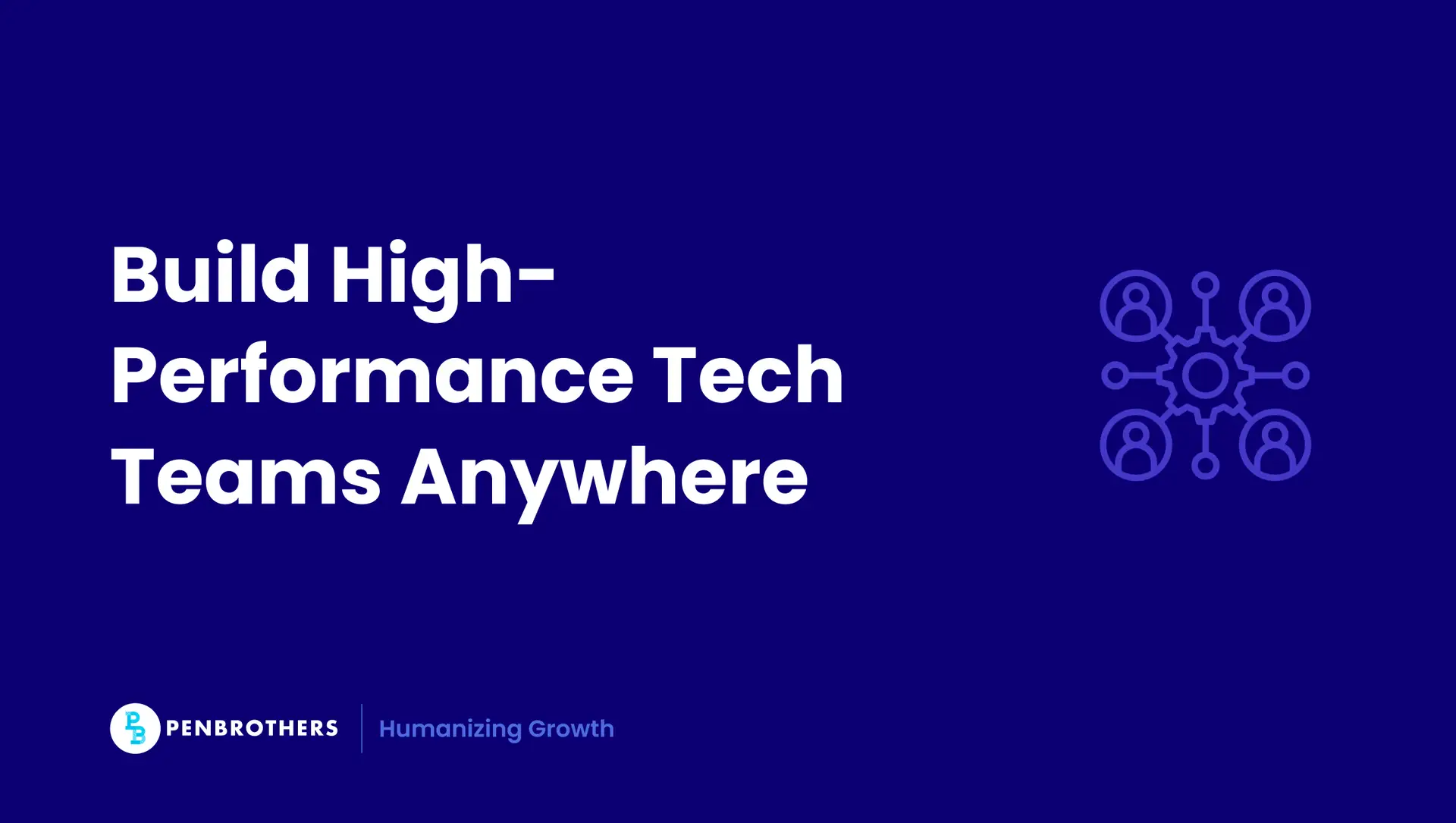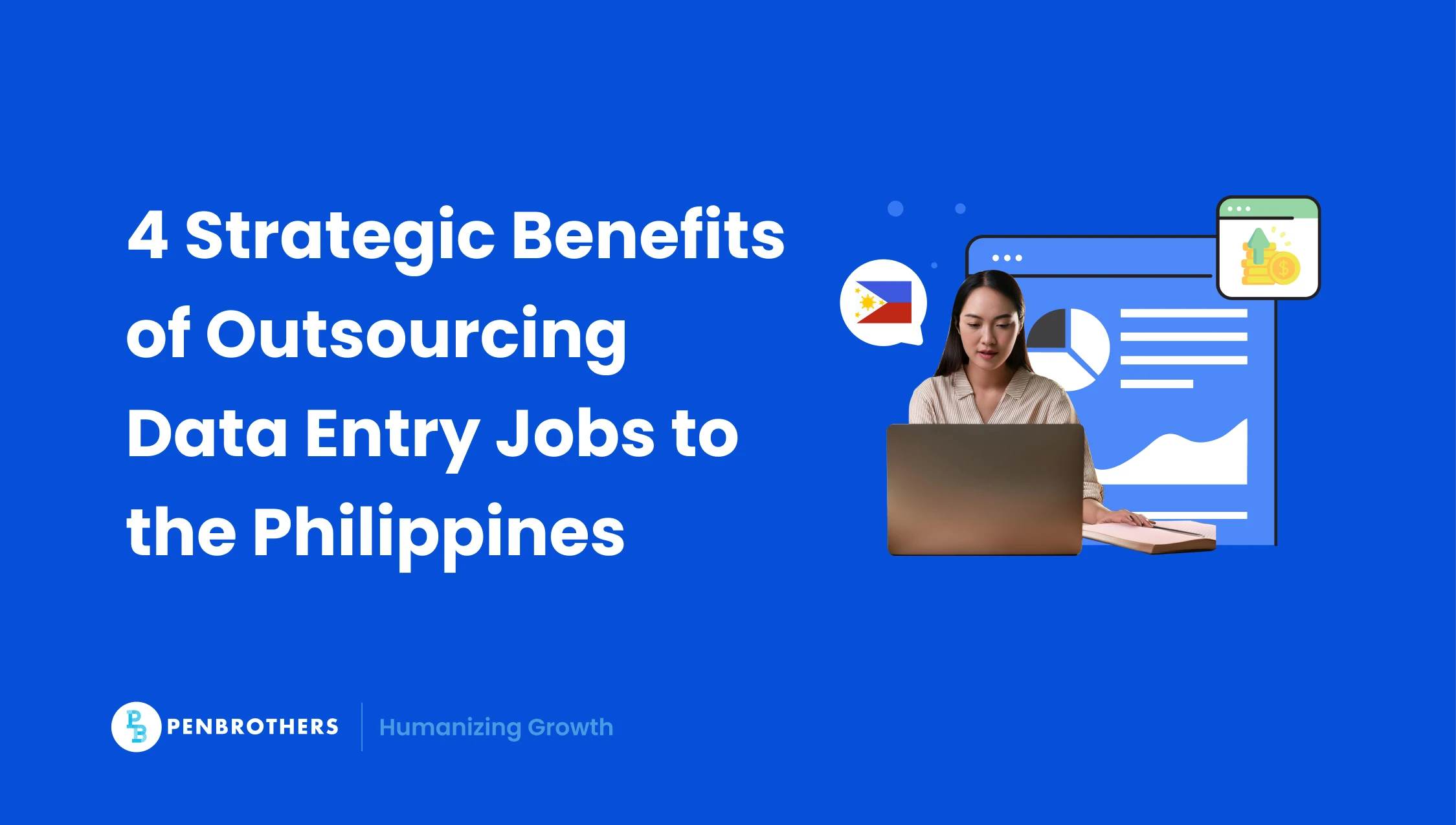What's Inside?
How to Build Scalable Tech Teams Through Software Development Outsourcing

In today’s fast-moving tech landscape, startups and enterprises share the same challenge: scaling quickly without burning out their teams or budgets. Internal engineers are stretched thin maintaining systems while the business demands faster releases, AI innovation, and global competitiveness. KPMG reports that 74% of private-sector companies say their decision-making processes for tech investments are clear, consistent and well-followed.
When speed, cost, and innovation collide, software development outsourcing becomes the lever that turns chaos into scalability. No longer just a cost-cutting tactic, it’s now a strategic path to growth.
This article breaks down what software development outsourcing really is, when it makes sense, the models to choose from, its benefits and risks, and how Penbrothers helps companies build scalable tech teams that deliver.
Key Takeaways
- A Strategic Tool for Scaling, Not Just Cost-Cutting: Modern software development outsourcing is a strategic lever for accessing scarce global talent, accelerating time-to-market, and achieving scalability. While cost savings are a benefit, the primary driver has shifted to gaining a competitive advantage in a market facing a severe tech talent shortage.
- Choosing the Right Engagement Model is Critical: There is no one-size-fits-all outsourcing model. Companies must choose the right fit for their needs, whether it’s Staff Augmentation (renting talent to plug into your team), Dedicated Teams (building a managed, autonomous pod), or Full-Cycle Development (delegating an entire project end-to-end).
- The Philippines Offers a Key Strategic Advantage: The Philippines is highlighted as a top offshore destination that balances cost and quality. It provides significant cost savings (up to 70%), a deep pool of English-proficient tech talent, and a strategic time zone that enables 24/7 “follow-the-sun” development cycles when paired with Western teams.
- Proactive Risk Management is Essential for Success: Outsourcing comes with real risks, including communication gaps, data security vulnerabilities, and misaligned expectations. Successful outsourcing initiatives mitigate these risks through a structured approach, including clear SLAs, robust security protocols (like NDAs and ISO standards), and a pilot phase to validate the partner.
What Is Software Development Outsourcing (and Why It Matters Now)
At its simplest, software development outsourcing means partnering with external experts to design, develop and maintain software systems rather than doing everything in-house. According to sources like Netguru and N‑iX, outsourcing in this context covers everything from engineering and QA to product support and ongoing maintenance. One recent market report forecasts the software development outsourcing market will reach approximately US$897 billion by 2030, growing at a 9.7% CAGR.
It’s not the same as the traditional notion of IT outsourcing, which once focused only on cost reduction but has now evolved into a strategy for scaling innovation and efficiency. Instead, modern software development outsourcing is a growth-enabling strategy: to access global talent, accelerate time-to-market, scale capacity up or down, and focus internal teams on core business innovation.
Why is this more critical now?
- Talent shortages: Demand for developers continues to outstrip supply. For example, the global number of software developers was forecast at 28.7 million in 2024.
- Digital transformation: Businesses of all sizes are racing to adopt cloud, microservices, AI/ML and mobile architectures. Outsourcing gives access to niche skills without long ramp-times.
- Speed matters: Startup and scale-up environments demand rapid prototyping, MVPs and product iteration. Outsourcing allows non-core development to happen in parallel with internal focus.
- Cost-and-scale balance: Handling growth without exploding head-count or overhead is a common problem. Outsourcing becomes a lever to maintain flexibility.
In short: the days when outsourcing meant just “cheap labour” are over. It now means “smart capacity and talent leverage” for scaling tech teams.
When Outsourcing Software Development Makes Sense
Not every situation calls for outsourcing. To decide when it makes sense, consider your business context and strategic goals. Here are key scenarios:
- Bandwidth or expertise gap: Internal teams are fully utilized with maintenance, bug-fixes or legacy support. You need extra hands (e.g., dev, QA, integration) to keep new initiatives moving without delaying critical business needs.
- Startups / high-growth companies: You have an MVP or early product, and you need to accelerate feature delivery or build new modules quickly to seize market opportunity. Outsourcing gives you additional capacity without the overhead of full hiring.
- Enterprises facing transformation: You’re modernising a legacy product, integrating AI or cloud, or shifting from monolith to microservices. You may need specialised skills (DevOps, cloud, data engineering) and external teams to support your roadmap.
- Scaling an existing product or filling short-term dev needs: For example, a mature product has a surge in feature demand or refactoring needs. Rather than hiring a whole team, you bring in an outsourcing partner to ramp up and then scale down.
- Focus on core business innovation: When you recognise that your internal team should focus on product strategy, architecture, critical modules while non-core or commoditised work can be delegated externally.
If any of these describe your situation, then outsourcing may make sense. The key is viewing it not as “outsource and forget” but as “outsource smartly within a scalable strategy.”
Key Outsourcing Models: Choosing What Fits Your Growth Stage
When building scalable tech teams through outsourcing, one size does not fit all. You need to choose the right engagement model according to your growth stage, control needs and roadmap.
Here are the major models:
1. Staff Augmentation / Team Extension
You bring in remote engineers, QA or other roles to plug into your existing in-house team. They follow your processes, tools and roadmap. Some of the top IT staff augmentation companies excel at this model, enabling startups and enterprises to scale engineering capacity fast without long recruitment cycles.
Use when: You want to maintain control of architecture and product strategy but need extra hands fast.
2. Dedicated or Managed Teams
You outsource to a provider who sets up, manages and scales a dedicated team (pod) aligned with your roadmap. The team may handle modules autonomously but works under your cadence.
Use when: You want a semi-autonomous team aligned with your product but still under your vision and leadership.
3. Full-Cycle Product Development
The outsourcing partner takes full ownership of design, architecture, development, deployment and maintenance. You specify the outcome and roadmap; they deliver end-to-end.
Use when: You have a defined product vision, clear roadmap, and you prefer to leave development management to the partner.
4. Geographical Models: On-shore, Near-shore, Offshore
These refer to location of the outsourcing team.
| Model | Cost | Collaboration / Time‐zone | Scalability |
| On-shore (same country/region) | Highest cost | Easiest collaboration | Moderate |
| Near-shore (adjacent/close time-zone region) | Medium cost | Good overlap | High |
| Offshore (farther region, lower cost) | Lowest cost for same specs | Time‐zone gap may exist | Very high |
Off-shore can give cost and scalability advantage but only if you mitigate communication/time-zone and cultural risks.
Benefits of Software Development Outsourcing (Beyond Cost Savings)
It’s tempting to think of outsourcing purely as a cost-cutting measure. But when done strategically, software development outsourcing becomes a growth multiplier.
Leading outsourcing software development companies prove that the real value lies in faster delivery, technical expertise, and seamless collaboration across time zones.
Here’s how:
- Access to global talent and emerging tech: You tap into developers with niche skills (cloud, AI/ML, automation frameworks) in regions where such expertise is abundant and cost-effective.
- Faster time-to-market: By ramping up teams externally, you reduce bottlenecks and accelerate feature delivery. Some reports say outsourcing can accelerate time-to-market by up to 50%.
- Scalability without overhead: Outsourcing allows you to scale up or down quickly without long-term commitments to additional full-time staff, office space or equipment.
- Focus internal teams on innovation: By moving non-core or support development externally, your internal talent can focus on architecture, strategic modules, product differentiation.
- Example client style result: A fast-growing SaaS startup engaged an outsourced dedicated engineering pod to build a mobile module in parallel with internal web development. They launched 6 weeks earlier than planned, enabling a faster sales cycle and an earlier +30 % ARR increase.
At Penbrothers, we help build offshore engineering pods that include dev, QA, PM and design, supported by our Hypercare onboarding and retention infrastructure ensuring the benefits above are realised with minimal friction.
Common Risks (and How to Outsmart Them)
No strategy is risk-free. Outsourcing carries its own set of challenges but the smart organisations mitigate them.
Communication and cultural gaps
Remote teams across time zones and cultures may lead to misunderstandings, slower feedback loops or misaligned expectations.
Solution: Ensure overlapping working hours, conduct cultural/communication alignment sessions, use clear meeting cadence, document processes and foster a single unified team mindset.
Data security and IP protection
Outsourcing means sharing access to code, product knowledge and sensitive systems. There is potential risk if proper security measures are not in place.
Solution: Use strict SLA’s, NDAs, DSM/ISO security frameworks, secure dev environments, defined roles and minimal privileged access. Choose vendors with security certifications and transparent policies.
Misaligned expectations or unclear scopes
Without clear definition of deliverables, timelines or KPIs, outsourcing can lead to scope creep, cost overruns or quality issues.
Solution: Define scope, deliverables, KPIs (e.g., velocity, code quality, delivery accuracy) upfront. Use milestones or pilot phases to validate alignment. Use transparent documentation and reporting frameworks.
Vendor dependency and knowledge transfer risks
Over-dependence on an external team can create lock-in or affect your ability to internalise knowledge later.
Solution: Choose partners that emphasise knowledge transfer, shadowing, documentation and transition plans. Build exit/continuity clauses if you ever need to internalise the team.
By proactively managing these risks you turn outsourcing from a gamble into a strategic enabler.
Cost Guide: What to Expect by Region and Model
Transparent cost data helps build trust and sets realistic expectations. Here are current benchmarks for outsourcing software development. As noted in our offshore IT staffing insights, Southeast Asia, particularly the Philippines, offers some of the most cost-efficient yet high-quality engineering talent pools for scaling teams.
Hourly rate averages by region
- Asia (e.g., Southeast Asia, Philippines): rates ranging around US$18-40 per hour.
- Eastern Europe: rates around US$30-60 per hour for many mid-level devs.
- Latin America: given near-shore advantages for North America, rates often fall in the US$25-50 per hour range.
- North America / Western Europe: significantly higher, often US$50-150+ per hour or more.
Breakdown of cost drivers
- Complexity & skill level: A senior engineer with AI/ML or cloud architecture will cost significantly more than a general web developer.
- Engagement model: A pure staff-augmentation (plug-in talent) may cost less than a full-cycle managed team which also includes oversight, process, QA, etc.
- Vendor location and maturity: More mature vendors charge higher rates but often deliver higher predictability and quality.
- Overhead and hidden costs: The “cheapest” hourly rate may end up costing more if rework, quality issues, delays or communication overhead occur.
- Time-zone and collaboration cost: Lower cost regions may incur higher cost in management, overlap time-zones, documentation or coordination.
- Long-term retention / knowledge transfer: Keeping a team engaged and aligned over time can add value (and cost) but reduces churn and onboarding risk.
Why cheapest isn’t always best
Choosing the lowest rate purely on cost can backfire: quality issues, high turnover, lack of process maturity and communication problems can nullify the cost advantage. The true value lies in predictability, scalability, aligned culture and long-term partnership.
Best Practices for Scalable Outsourcing Partnerships
To build a scalable tech team through outsourcing, use a clear playbook, not ad hoc adoptions. Here are best practices:
1. Start with a Discovery or Pilot Phase
Before committing to a full engagement, run a short discovery or pilot phase (typically 4–8 weeks). Use this time to validate technical capabilities, communication flow, and cultural fit. A structured pilot helps both sides refine expectations early and avoid costly misalignment later.
2. Define KPIs from Day One
Set measurable performance metrics at the start, velocity (story points per sprint), code quality (bug rates, test coverage), delivery predictability (planned vs. actual), and team retention. These indicators form the foundation for continuous improvement and transparent evaluation.
3. Maintain Transparent Documentation and Communication
Transparency builds trust. Use unified tools like Jira, Confluence, and Slack to share progress, sprint reviews, and retrospectives. Keep documentation centralized, decisions visible, and communication frequent. This ensures the outsourced team moves in sync with your internal roadmap.
4. Prioritize Partners with Knowledge Transfer and Retention Frameworks
Scalability fails when knowledge stays siloed. Work with partners who emphasize structured handovers, documentation, code reviews, and succession planning. A mature outsourcing partner invests in training and career growth to keep key talent engaged and institutional knowledge intact.
5. Align Culture and Integration
The most successful partnerships blur the line between “in-house” and “outsourced.” Include external teams in product discussions, agile ceremonies, and company updates. Recognizing their contributions fosters ownership, improves morale, and builds long-term commitment.
6. Bake Security and Compliance into the Foundation
Security cannot be an afterthought. Contracts should include standards such as ISO 27001 compliance, GDPR or SOC 2 (where applicable), IP ownership clauses, and clear data-access protocols. A partner’s security maturity directly impacts your risk exposure.
7. Design for Scalability and Flexibility
Business needs evolve, your outsourcing setup should too. Use engagement models that allow team ramp-up or ramp-down without friction. Define milestone reviews, exit clauses, and budget transparency upfront to ensure agility as priorities shift.
8. Maintain Internal Governance and Technical Ownership
Outsourcing doesn’t mean offloading responsibility. Keep strategic control of architecture, product roadmap, and design decisions. External teams execute delivery; internal leaders ensure alignment with long-term business goals. This balance safeguards product integrity as you scale.
By adhering to these practices you ensure the outsourced team doesn’t just help. you becomes a strategic extension of your tech organisation.
Future Trends Shaping Software Outsourcing in 2025 and Beyond
To stay ahead, you should look past the present and anticipate the shifts shaping outsourcing in the next several years:
AI-assisted development & low-code/no-code
Outsourcing partners will increasingly leverage AI-driven tools (code generation, test automation, devops) and low-code platforms, changing the nature of what teams deliver and how.
Value-based outsourcing (quality over cost)
The shift will move from “hours billed” to “value delivered” models (outcome-based contracts) where the partner is aligned on business results, not just task completion.
Sustainability and green-coding initiatives
As ESG becomes business-critical, outsourcing frameworks will increasingly include carbon footprint, energy-efficient code, sustainable operations and ethical labour practices.
Rise of multi-cloud, cybersecurity-driven outsourcing
With increasing regulatory, security and cloud complexity, outsourcing teams will need deep skills in secure architecture, cloud-native operations and governance.
Hybrid engagement models and distributed pods
Rather than “build offshore team only”, successful models will mix near-shore and offshore, build globally distributed pods and blend internal + outsourced + vendor teams as a unified ecosystem.
Talent marketplaces and distributed workforce ecosystems
The growth of remote work and global talent platforms means outsourcing is not just “vendor contract” but access to networked talent, fractional pods, flex teams and skill-on-demand models.
These trends mean that companies looking to build tech teams via outsourcing must think long-term, not just cost-short-term.
How Penbrothers Builds Scalable Tech Teams Through Outsourcing
At Penbrothers we’ve structured our offering to support global companies (startups, scale-ups, enterprises) looking for dependable offshore engineering teams. Here’s how we deliver value:
Hypercare onboarding and retention
We don’t just hire and hand over. Our Hypercare Framework ensures smooth integration, induction, cultural alignment, performance tracking, retention support and career-pathing, all designed to reduce churn and maximise team stability.
Fully supported dedicated engineering pods
Whether you need dev, QA, PM, design and whether you need an extension of your team or a managed pod, we build cohesive teams aligned with your roadmap, tools and culture.
Scalable partnership infrastructure
We manage HR, compliance, payroll, benefits, onboarding, local team management, your team acts like an extension of your business, not a disconnected vendor. You focus on product and strategy, we handle the rest.
Transparency and flexibility
We work with clear SLAs, reporting, KPI dashboards, regular check-ins and alignment to your business goals. We also support ramping up/down as required without penalty.
Focus on high-quality remote talent in the Philippines
Based in the Philippines, we tap into a large pool of tech, creative and support talent with strong English skills and cultural alignment to Western clients. This gives you a strategic offshoring destination balancing cost, quality and time-zone compatibility.
Final Thoughts
Growth in tech is not just about hiring more people. It’s about building the right team, with the right skills, at the right time. Software development outsourcing is not a shortcut, it’s a strategic enabler of scalability, innovation and global competitiveness.
When you outsource thoughtfully, choosing the right model, managing the risks, defining clear KPIs, aligning culture and communication, you unlock the ability to scale fast and stay focused on your core business.
We invite you to talk to Penbrothers about how to build your scalable offshore tech team. Let us help you move from scaling chaos to scalable strategy.
Frequently Asked Questions
It is the strategic practice of partnering with an external company to handle some or all of your software development functions, such as engineering, quality assurance (QA), and product maintenance, rather than building and managing these functions entirely in-house.
It is strategic because it directly addresses the biggest challenges in the tech industry: the global talent shortage of skilled developers, the need to accelerate time-to-market to stay competitive, and the pressure to manage costs and scale operations flexibly without the overhead of a large permanent in-house team.
There are three main models:
Staff Augmentation: You add individual remote developers from a partner directly into your existing team, and you manage their daily work.
Dedicated Team: A partner builds and manages a full, dedicated team (or “pod”) that works exclusively on your projects under your strategic direction.
Full-Cycle Product Development: You hand over an entire project (like an MVP) to a partner, who manages the process from design to deployment.
The biggest risks are communication barriers due to time zones and culture, data security and IP protection vulnerabilities, and misaligned expectations leading to poor quality. These are managed by choosing a partner with strong security certifications (like ISO 27001), establishing clear KPIs and SLAs, and ensuring a period of daily work overlap for communication.
Costs vary by region. Offshore locations like the Philippines offer the most savings, with hourly rates typically ranging from $18 to $40. Nearshore locations in Latin America are often in the $25 to $50 range, while Onshore (domestic) rates can be $50 to $150+ per hour.
*This article was crafted with the support of AI technology and refined by a human editor.





